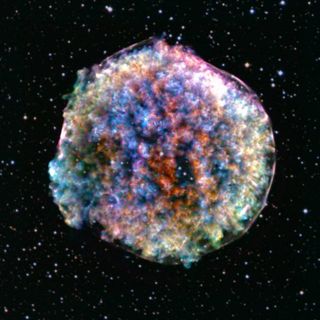On this day in space! Nov. 6, 1572: Tycho supernova discovered
On Nov. 6, 1572, the German astronomer Wolfgang Schulër observed a supernova with his bare eyes.
On Nov. 6, 1572, the German astronomer Wolfgang Schulër observed a supernova with his bare eyes. He spotted the exploding star in the constellation Cassiopeia. It was as bright as Venus and could even be seen during the day.
Supernova Photos: Great Images of Star Explosions
Astronomers were really confused, because it looked like a star just appeared out of nowhere. Schulër may have been the first to see it, but the Danish astronomer Tycho Brahe is widely credited for the discovery. Brahe studied it in detail and wrote a whole book about this so-called "new star." It then became known as "Tycho's Star."

At the time, supernovas had not yet been discovered. Tycho's Star was finally classified as a supernova in the 1940s. Scientists now think it was a small star called a white dwarf that exploded thousands of years ago. Because Tycho's Star is 13,000 light-years from Earth, it took a while before anyone could see it.
On This Day in Space Archive!
Still not enough space? Don't forget to check out our Space Image of the Day, and on the weekends our Best Space Photos and Top Space News Stories of the week.
Get the Space.com Newsletter
Breaking space news, the latest updates on rocket launches, skywatching events and more!
Join our Space Forums to keep talking space on the latest missions, night sky and more! And if you have a news tip, correction or comment, let us know at: community@space.com.

Hanneke Weitering is a multimedia journalist in the Pacific Northwest reporting on the future of aviation at FutureFlight.aero and Aviation International News and was previously the Editor for Spaceflight and Astronomy news here at Space.com. As an editor with over 10 years of experience in science journalism she has previously written for Scholastic Classroom Magazines, MedPage Today and The Joint Institute for Computational Sciences at Oak Ridge National Laboratory. After studying physics at the University of Tennessee in her hometown of Knoxville, she earned her graduate degree in Science, Health and Environmental Reporting (SHERP) from New York University. Hanneke joined the Space.com team in 2016 as a staff writer and producer, covering topics including spaceflight and astronomy. She currently lives in Seattle, home of the Space Needle, with her cat and two snakes. In her spare time, Hanneke enjoys exploring the Rocky Mountains, basking in nature and looking for dark skies to gaze at the cosmos.
-
Arc Light Just so you know, the X-15 took off from Edwards AFB under the wing of a B-52 & was airdropped over Delamar Dry Lake, Nevada. The flight to the altitude record wasn't planned, but the rocket engine burned for two seconds longer than expected. The test flight was scheduled to peak at 280,000', but actually reached 314, 750' due to the extra rocket burn time.Reply -
Fourth Root Misleading wording. Bob White did not set the world altitude record on July 17th, 1962. Four Astronauts and two cosmonauts had flown higher prior to his flight. One could say it was the highest manned flight of a winged craft. But that's not the wording that was used.Reply -
DrRaviSharma On this date in 1969, I was part of NASA Apollo TeamReply
Contributed to Experiments in orbit and on Surface of Moon (ALSEP) etc.also trained astronauts
Studied containation on and ouside Spacecraft.
The Moon gave me employment to work for 5 Years on exciting Human Space flight Programs Skylab, Planning of Space Station and Space Shuttle
See My picture taken with Buzz Aldrin in 2009
https://www.space.com/india-moon-landing-not-a-failure.html
I received Apollo Achievement Award from NASA dated July 20, 1969.
Thanks Hanneke Weitering for today's Historic post
Ravi
Dr. Ravi Sharma -
Mergatroid "Allegedly, the moon turns green because of its close proximity to Uranus"Reply
I'm sorry about that. I hear they have been investigating x-rays from the same source. I had no idea. I'll get a doctor to check into it.
Sorry everyone.
Sorry...